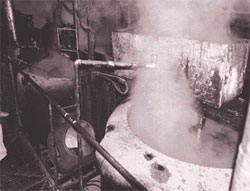Loss of the wild
 the heavy demand on plant resources has led to rapid depletion of populations. Some medicinal plants are now endangered. A recent report of the ministry of environment and forests (Medicinal plants of India: Guidelines for national policy and conservation programmes) acknowledges that medicinal plants are under serious threat due to habitat degradation, loss and over-extraction. The gap between demand and supply is increasing progressively. In 1987, for instance, the ministry of health estimated that the demand for Picrorhiza kurrooa (or kutki , used to treat liver diseases) was 5,000 tonnes, while that for Gentiana kurrooa (gentian, used in treatment of digestive disorders and as a tonic) was around 100 tonnes.
the heavy demand on plant resources has led to rapid depletion of populations. Some medicinal plants are now endangered. A recent report of the ministry of environment and forests (Medicinal plants of India: Guidelines for national policy and conservation programmes) acknowledges that medicinal plants are under serious threat due to habitat degradation, loss and over-extraction. The gap between demand and supply is increasing progressively. In 1987, for instance, the ministry of health estimated that the demand for Picrorhiza kurrooa (or kutki , used to treat liver diseases) was 5,000 tonnes, while that for Gentiana kurrooa (gentian, used in treatment of digestive disorders and as a tonic) was around 100 tonnes.
According to the World Bank, 96 per cent of the herbs used in commercially available preparations are collected from the wild. A number of herbs and medicinal plants can be cultivated for commercial use, but there is little effort on the part of the industry in this direction. Of the 400-odd plant species used, less than 20 are being commercially cultivated.
Herbs are supplied by traders, who buy it mainly from people in tribal or rural areas at cheap prices. Along the distribution chain, the herbs and plant products become costlier. Adulteration is common. Sanjay Aggarwal of the Delhi-based company National Herbs laments that there is no quality control on herbs available in Indian markets. “You are not sure of what you are consuming.”
At the same time, the people
Related Content
- Project tiger: 50 years of tiger conservation in India
- Aquaculture and nature-based solutions: identifying synergies between sustainable development of coastal communities, aquaculture, and marine and coastal conservation
- Best Practices of Human Elephant Conflict Management in India
- Wild seve: A novel conservation intervention to monitor and address human wildlife conflict
- Recovery of Dugongs and their habitats in India (June 2018-July 2019)
- The State of World Fisheries and Aquaculture 2018: meeting the sustainable development goals.
